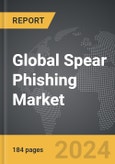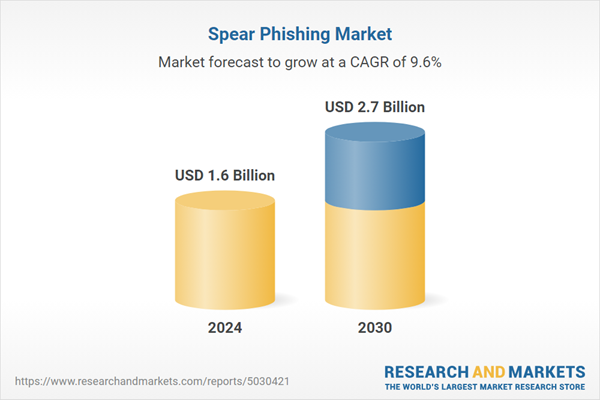The global market for Spear Phishing was valued at US$1.6 Billion in 2024 and is projected to reach US$2.7 Billion by 2030, growing at a CAGR of 9.6% from 2024 to 2030. This comprehensive report provides an in-depth analysis of market trends, drivers, and forecasts, helping you make informed business decisions. The report includes the most recent global tariff developments and how they impact the Spear Phishing market.
Segments: Component (Services, Solutions); Deployment (On-Premise Deployment, Cloud, Hybrid); Organization Size (Large Enterprises, SMEs); Vertical (BFSI, Government & Defense, Critical Infrastructure, Healthcare, Manufacturing, Retail, Other Verticals).
Geographic Regions/Countries: World; United States; Canada; Japan; China; Europe (France; Germany; Italy; United Kingdom; and Rest of Europe); Asia-Pacific; Rest of World.
The analysts continuously track trade developments worldwide, drawing insights from leading global economists and over 200 industry and policy institutions, including think tanks, trade organizations, and national economic advisory bodies. This intelligence is integrated into forecasting models to provide timely, data-driven analysis of emerging risks and opportunities.
Global Spear Phishing Market - Key Trends and Drivers Summarized
Why Is Spear Phishing Becoming a Critical Concern for Organizations Worldwide?
Spear phishing, a targeted form of phishing that uses personalized and sophisticated tactics to deceive individuals into divulging sensitive information, has emerged as a significant cybersecurity threat for organizations worldwide. Unlike traditional phishing attacks, spear phishing targets specific individuals, such as executives, finance personnel, or IT administrators, using detailed information obtained from social engineering, research, or prior breaches. These attacks often mimic legitimate communication channels, making them difficult to detect and defend against. With the increasing digitalization of business processes and the proliferation of remote work and BYOD (Bring Your Own Device) practices, the vulnerability to spear phishing attacks has grown exponentially, making it a top priority for organizations to invest in advanced cybersecurity solutions and employee awareness programs.How Are Technological Advancements Enhancing Spear Phishing Detection and Prevention?
Technological advancements in artificial intelligence (AI), machine learning (ML), and behavioral analytics are significantly enhancing the detection, prevention, and response capabilities against spear phishing attacks. AI-powered anti-phishing solutions can analyze large volumes of emails and communication patterns in real-time to identify anomalies, suspicious links, and malicious attachments. Machine learning algorithms continuously learn from past incidents and threat intelligence feeds to predict and prevent future attacks, while natural language processing (NLP) techniques help identify spoofed emails and impersonation attempts. The integration of multi-layered security architectures, including Secure Email Gateways (SEGs), Endpoint Detection and Response (EDR) systems, and Zero Trust models, is further strengthening the defense against spear phishing, enabling organizations to build a more resilient cybersecurity posture.Which Market Segments Are Leading the Growth of the Spear Phishing Industry?
Solution types include anti-phishing software, email security solutions, and threat intelligence services, with email security solutions holding the largest market share due to their comprehensive protection against phishing, spam, and malware. Deployment modes comprise cloud-based and on-premises solutions, with cloud-based solutions dominating the market owing to their scalability, flexibility, and ease of integration with existing IT infrastructures. End-use sectors span banking, financial services, insurance (BFSI), healthcare, government, IT and telecommunications, and retail, with BFSI being the dominant segment due to the high risk of financial fraud and data breaches. Geographically, North America and Europe are the largest markets for spear phishing solutions, driven by stringent regulatory requirements and high cybersecurity awareness, while Asia-Pacific is expected to witness significant growth due to increasing digital transformation and rising cyber threats.What Are the Key Drivers of Growth in the Spear Phishing Market?
The growth in the spear phishing market is driven by several factors, including the rising threat of cyberattacks and targeted phishing campaigns, technological advancements in AI, ML, and threat intelligence, and the increasing adoption of cloud-based security solutions. The need to provide comprehensive protection against sophisticated phishing attacks, business email compromise (BEC), and credential harvesting is driving the demand for spear phishing solutions across various sectors. Technological innovations in AI-powered, context-aware, and behavioral-based detection and prevention systems, coupled with advancements in multi-layered security architectures, Zero Trust models, and automated incident response, are enhancing the effectiveness and resilience of spear phishing defenses, supporting market growth. The expansion of spear phishing solutions in BFSI, healthcare, government, and IT sectors, along with the growing emphasis on continuous monitoring, user awareness, and regulatory compliance, is creating new opportunities for market players. Additionally, the focus on developing adaptive, integrated, and proactive spear phishing prevention strategies is further propelling the growth of the spear phishing market.Report Scope
The report analyzes the Spear Phishing market, presented in terms of units. The analysis covers the key segments and geographic regions outlined below.Segments: Component (Services, Solutions); Deployment (On-Premise Deployment, Cloud, Hybrid); Organization Size (Large Enterprises, SMEs); Vertical (BFSI, Government & Defense, Critical Infrastructure, Healthcare, Manufacturing, Retail, Other Verticals).
Geographic Regions/Countries: World; United States; Canada; Japan; China; Europe (France; Germany; Italy; United Kingdom; and Rest of Europe); Asia-Pacific; Rest of World.
Key Insights:
- Market Growth: Understand the significant growth trajectory of the Services segment, which is expected to reach US$1.8 Billion by 2030 with a CAGR of a 9.0%. The Solutions segment is also set to grow at 10.8% CAGR over the analysis period.
- Regional Analysis: Gain insights into the U.S. market, valued at $434.2 Million in 2024, and China, forecasted to grow at an impressive 8.9% CAGR to reach $414.4 Million by 2030. Discover growth trends in other key regions, including Japan, Canada, Germany, and the Asia-Pacific.
Why You Should Buy This Report:
- Detailed Market Analysis: Access a thorough analysis of the Global Spear Phishing Market, covering all major geographic regions and market segments.
- Competitive Insights: Get an overview of the competitive landscape, including the market presence of major players across different geographies.
- Future Trends and Drivers: Understand the key trends and drivers shaping the future of the Global Spear Phishing Market.
- Actionable Insights: Benefit from actionable insights that can help you identify new revenue opportunities and make strategic business decisions.
Key Questions Answered:
- How is the Global Spear Phishing Market expected to evolve by 2030?
- What are the main drivers and restraints affecting the market?
- Which market segments will grow the most over the forecast period?
- How will market shares for different regions and segments change by 2030?
- Who are the leading players in the market, and what are their prospects?
Report Features:
- Comprehensive Market Data: Independent analysis of annual sales and market forecasts in US$ Million from 2024 to 2030.
- In-Depth Regional Analysis: Detailed insights into key markets, including the U.S., China, Japan, Canada, Europe, Asia-Pacific, Latin America, Middle East, and Africa.
- Company Profiles: Coverage of players such as BAE Systems PLC, Barracuda Networks, Inc., Check Point Software Technologies Ltd., Cisco Systems, Inc., Cofense and more.
- Complimentary Updates: Receive free report updates for one year to keep you informed of the latest market developments.
Some of the 22 companies featured in this Spear Phishing market report include:
- BAE Systems PLC
- Barracuda Networks, Inc.
- Check Point Software Technologies Ltd.
- Cisco Systems, Inc.
- Cofense
- Forcepoint LLC
- Greathorn, Inc.
- Intel Security Group
- IronScales
- Microsoft Corporation
- Mimecast
- Phishlabs
- Proofpoint, Inc.
- Rsa Security LLC
- Sophos Ltd.
- Symantec Corporation
- Trend Micro, Inc.
- Votiro Inc.
Tariff Impact Analysis: Key Insights for 2025
Global tariff negotiations across 180+ countries are reshaping supply chains, costs, and competitiveness. This report reflects the latest developments as of April 2025 and incorporates forward-looking insights into the market outlook.The analysts continuously track trade developments worldwide, drawing insights from leading global economists and over 200 industry and policy institutions, including think tanks, trade organizations, and national economic advisory bodies. This intelligence is integrated into forecasting models to provide timely, data-driven analysis of emerging risks and opportunities.
What’s Included in This Edition:
- Tariff-adjusted market forecasts by region and segment
- Analysis of cost and supply chain implications by sourcing and trade exposure
- Strategic insights into geographic shifts
Buyers receive a free July 2025 update with:
- Finalized tariff impacts and new trade agreement effects
- Updated projections reflecting global sourcing and cost shifts
- Expanded country-specific coverage across the industry
Table of Contents
I. METHODOLOGYII. EXECUTIVE SUMMARY2. FOCUS ON SELECT PLAYERSIII. MARKET ANALYSISIV. COMPETITION
1. MARKET OVERVIEW
3. MARKET TRENDS & DRIVERS
4. GLOBAL MARKET PERSPECTIVE
UNITED STATES
CANADA
JAPAN
CHINA
EUROPE
FRANCE
GERMANY
ITALY
UNITED KINGDOM
REST OF EUROPE
ASIA-PACIFIC
REST OF WORLD
Companies Mentioned (Partial List)
A selection of companies mentioned in this report includes, but is not limited to:
- BAE Systems PLC
- Barracuda Networks, Inc.
- Check Point Software Technologies Ltd.
- Cisco Systems, Inc.
- Cofense
- Forcepoint LLC
- Greathorn, Inc.
- Intel Security Group
- IronScales
- Microsoft Corporation
- Mimecast
- Phishlabs
- Proofpoint, Inc.
- Rsa Security LLC
- Sophos Ltd.
- Symantec Corporation
- Trend Micro, Inc.
- Votiro Inc.
Table Information
| Report Attribute | Details |
|---|---|
| No. of Pages | 184 |
| Published | April 2025 |
| Forecast Period | 2024 - 2030 |
| Estimated Market Value ( USD | $ 1.6 Billion |
| Forecasted Market Value ( USD | $ 2.7 Billion |
| Compound Annual Growth Rate | 9.6% |
| Regions Covered | Global |









